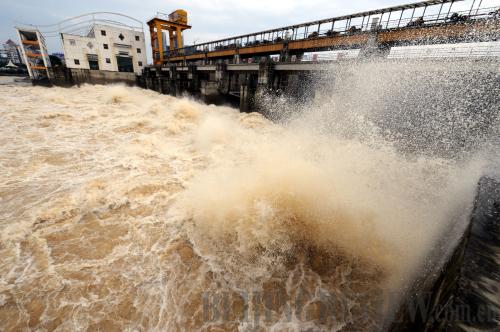|
 |
|
DRAINED FOR SAFETY: The reservoir at a hydroelectric station in Fujian Province is drained on June 19 because of sudden increases in the river (XINHUA) |
For three days, a torrential downpour pounded Wangmo, a small mountainous county in southwest China's Guizhou Province. The June 3-5 rains triggered devastating floods that claimed 20 lives. More than 30 people went missing and countless homes and farms were destroyed.
A day prior, local farmers were busy figuring out ways to alleviate the drought that had plagued their home villages for five months. Then the rains came.
Currently extreme weather phenomena like this are damaging the economies and people's lives along the Yangtze River region across south China.
On June 6, Chen Lei, Minister of Water Resources and deputy head of the Office of State Flood Control and Drought Relief (SFDH), called on local governments to closely monitor weather changes and keep emergency relief teams on standby.
Such is the problem facing south China: A complete absence of rainwater followed by sheer inundation presenting challenges for local governments as they hurry to solve the dilemma of alleviating drought while draining flooded areas.
A sharp turn
Rain was scarce along the Yangtze River this spring, and the resulting drought caused water levels to drop to record lows.
Statistics from the SFDH said by May 29, the acreage of drought-affected farmland nationwide had reached 6.96 million hectares. In Jiangsu, Anhui, Jiangxi, Hubei and Hunan—the five provinces on the middle and lower reaches of the Yangtze River, local rainfall decreased 40 to 60 percent year on year, the lowest since 1951. The accumulated inflows of major tributaries on the middle and lower reaches of the Yangtze River decreased 10 to 70 percent between January and May.
In May, the Central Government allocated 2.337 billion yuan ($360.65 million) to the five provinces for drought relief. The SFDH head also sent out experts to inspect and guide their drought relief efforts. But the rainstorm in early June caught them off guard.
The early June downpours, while destructive, helped ease the drought in the region, decreasing the drought-hit area by 39.2 percent and lowering the drought-affected population by 1.68 million to 2.15 million by June 6.
The positive effects of the rainfall, however, were overshadowed by the following floods that hit hard some regions in Hunan and Guizhou provinces.
Lingering impact
The worries about local people's drinking water and navigation on the Yangtze River that were so abundant during the drought were washed away with the rainfall, but the drought's impact on agriculture and animal husbandry remains.
| 